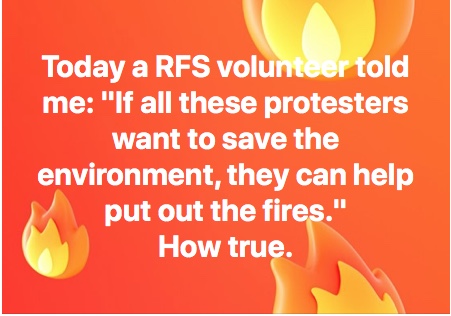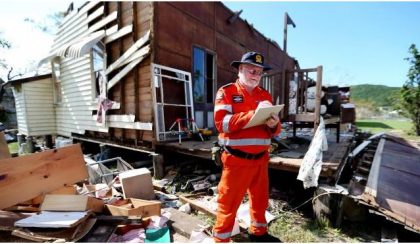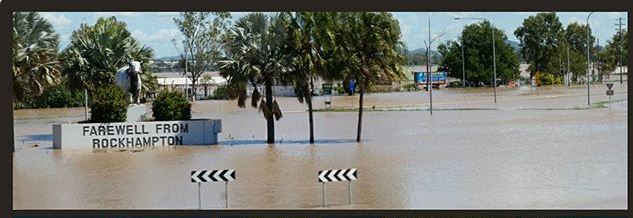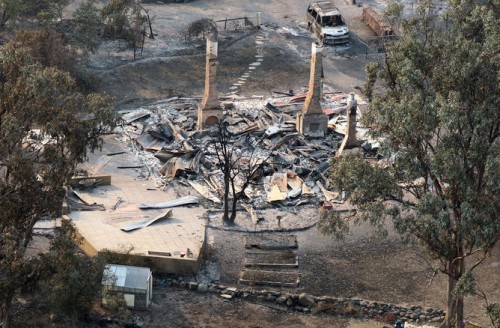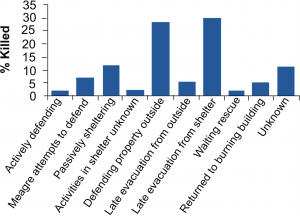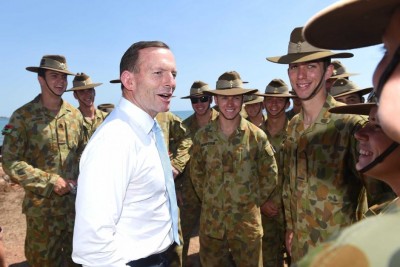Now is the time, Mr Morrison
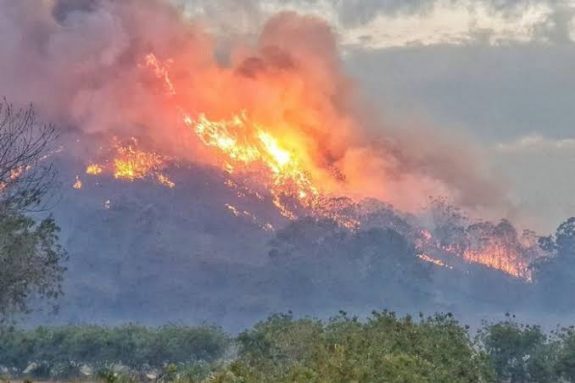
“In this bucket is my house,” Aaron Crowe tells other unquiet Australians rallying in Macquarie St, Sydney, Tuesday. He lifts an organic compost bin, a repurposed twenty-gallon steel red drum with hand-made wooden lid, a homely relic of former peaceful, rural domesticity, now, destroyed forever, aloft.
The 38 year-old-father tips a few charred, remnants of the two-bedroom home he once built, himself, on to the footpath outside NSW’s Parliament. Crowe and his wife, Fiona Lee, journey 323 kilometres, from Warrawillah, near Bobin, SW of Port Macquarie, to call MPs to account; confront them with the truth.
A powerful, personal, rebuke to the spin-doctors and MSM who drown real voices out of public discourse
Crowe’s gesture is eloquent testimony to a terrifying new bushfire season and a call to authorities, especially NSW state politicians in charge of funds and resources that it’s time to get real about climate science. Communicating climate science through our commercial media with its spectacularisation at the expense of underlying issues, its government media drops and its climate denialism is now impossible.
The challenge of communication has been taken up by independent media, social media, conferences, public meetings and personal protests. No wonder our anti-activist PM has these in his sights.
Crowe testifies to how global warming has bred extreme bushfires against which there is no defence.
“We had ample time to prepare and they’re talking about hopes and dreams, thoughts and prayers, miracles and heroes – it’s not realistic. This is not about unicorns and fairies, this is about people’s lives, it’s only going to get worse.” Yet Aaron Crowe’s plea is waived aside by his premier and his PM.
Now is not the time to talk about climate change chorus NSW Premier Gladys Berejiklian and PM Morrison, Tuesday. Bushfire survivor, Badja Sparks contextualises this for The Guardian Australia.
“Today is not the day to talk about climate change.” No, yesterday was, or the day before, or the month before, or the year before. But it didn’t get a mention.
Now we have the reality, and the mention it gets is: “Don’t talk about it now.”
So the politicians (and the media) turn the talk to hazard reduction burns, or the lack of them, as something else to blame on the “inner-city raving lunatics”.
“We had a bushfire two months ago that burned most of our property. It didn’t matter. It burned again.” Badja attests to a terrifying new type of fire that defies traditional means of control. A crown fire roaring in from the west on a hot afternoon with an 80km/h wind – it wasn’t on the ground. It was a firestorm in the air – raining fire. There was no fuel on the ground; it was already burned.
“Now is not the time” is a tactic the US National Rifle Association (NRA) uses to silence of debate.
NRA “spokespersons” or “public faces” such as Dana Loesch are quick to claim “now is not the time to talk gun control” after so many of the 36,000 plus annual fatal shootings that make USA’s rate of death by firearm the highest in the developed world. Clearly, not talking works – for the gun lobby.
And for the government. Coalition shill, Chris Kenny in The Australian declares, “Climate alarmists are brazen opportunists preying on misery.” Pushing the Morrison government’s political barrow he writes,
“Climate alarmists are using tragic deaths and community pain to push a political barrow. Aided by journalists and others who should know better, they are trying to turn a threat endured on this continent for millennia into a manifestation of their contemporary crusade.”
In “more of the same just more of the same” false equivalence, Kenny’s failure to research any of the characteristics that make the current fires unique does his readers a dangerous disservice.
So, too, does what was once the party of the bush, The Nationals. Now the burnt out people of the bush feel increasingly betrayed by National Party MPs. All MPs. Crikey’s Guy Rundle argues that the Nationals have made themselves the enemy of rural Australia’s survival. Catastrophic fires occur so often now that they are “beginning to wear down the resistant scepticism of large areas of rural Australia”.
When country folk could once pride themselves if not define themselves on the thought that city folk didn’t know what they were talking about, the reality of drought and bushfire has caused a re-think.
Increasingly extreme weather; the lived experience of rural voters tests their dogged loyalty to The National Party and its blind faith in climate science denial. It’s at odds with their own everyday reality.
Undermined is the nub of rural identity which values bush experience and concrete realities over abstract science. Now that rural National voters’ bushfire experience is matching scientists’ warnings, Rundle perceives a weakening of “folk denialism”; traces an awakening of respect for climate science.
It’s complex. Adding to voters’ alienation is the Nationals’ support for mining over farmers. On Channel 10’s The Project, Waleed Ali stumps Michael McCormack in March when he challenges the deputy PM,
“Could you name a single, big policy area where the Nats have sided with the interests of farmers over the interest of miners when they come into conflict?”
Within the network of influence and lobbying which mining holds over the Coalition, Rundle traces a moment when the Nationals as an organisation lost interest in representing their agrarian community.
“Former party leader Anderson became chairman of Eastern Star Gas. His successor in the Nationals, Mark Vaile, now sits on the board at Whitehaven Coal, against which farmers in the Liverpool Plains have staged hundreds of days of blockades. Party scion Larry Anthony was a lobbyist for the Shenhua Watermark mine.”
John Anderson pops up like the White Rabbit on ABC’s The Drum last Friday to falsely claim that “the scientists cannot directly link extreme weather events with climate change”. But they can. And do. And our leaders – must heed them. The Australia Institute economist, Richard Dennis sums up,
Climate change makes bushfires worse. Even if we catch an arsonist who lights a fire, the fact is the fires they light will burn further and faster than they would have if the world had burned less coal, and the temperature was lower than we have made it.
We can manage fuel loads; cut firebreaks, but a fire lit by an arsonist will spread further today. Embers from hotter fires, race across drier ground; spark new fires further from the fire front than ever before.
First the women, younger folk and community leaders are sceptical of the Nationals’ bush mythology. Now, Rundle believes Nationals’ voters’ crisis of faith may harden into one final act of resistance before it cracks irrevocably. Attacking The Greens is one last populist move to regain a show of leadership.
On Monday’s RN Breakfast, McCormack is stung by Greens MP Adam Bandt’s claim that Morrison’s coal-promotion makes him complicit in the suffering of those currently being burnt out by extreme bushfires.
What people need now, the Deputy PM says, is real practical assistance, not “the ravings of some pure, enlightened and woke capital-city greenies”.
To Mid-Coast Councillor, Claire Pontin, McCormack is “just saying silly things.” He and Joyce may have missed this pivotal change in their own constituencies, notes The Saturday Paper’s Paul Bongiorno drily.
The best real, practical assistance McCormack could offer would be to embrace the science. Then he might ask NSW’s premier to reinstate the tens of millions the NSW has cut from state fire services.
Denial, downplaying and disinformation costs lives – especially the myth of false equivalence which holds that both sides are too blame for inaction on climate change, a term which is itself spin-doctored because it’s a neutral substitute for global warming. In fact, it’s pretty much all the Coalition’s own work.
And much of that work was achieved by one man. Tony Abbott seized a personal political chance in 2009, writes The Monthly Today’s Paddy Manning, “sold the truth down the river” and in 2014, pre-figured Trump in becoming world’s first political leader to repeal a carbon price. Abbott then agitated against the NEG, creating waves of instability that helped Morrison topple Turnbull. Not only did Abbott put the nation back at least a decade, his legacy continues in Morrison’s lack of energy policy.
To adapt Katharine Murphy’s phrase, no wonder Morrison’s government doesn’t want anyone to talk about climate science, its own record is one of unmitigated shame and ignominious failure.
Yet McCormack insists we shouldn’t be talking about climate change. “Australia’s always burned,” he says. Nothing to see here. Just bushfires that come earlier, stay longer, burn hotter, higher and spread faster; evolving into a threat, unlike anything we’ve had to deal with before.
The deputy PM follows up with NRA tactic stage two: shift the blame. If only greenies weren’t locking up our state forests for ecotourism, we could get in and cut the fuel load. Yet only nine per cent of NSW is “locked”. Only Queensland is lower with a shameful eight per cent.
Greenies, moreover, have no issue with hazard reduction. It’s climate change itself which increasingly restricts burning off. As the fire season extends, south-east Australia dries out. Opportunities to use controllable, low-intensity fire to burn off the litter become fewer.
Above all, not all forest types are amenable to hazard reduction. Wet sclerophyll and rainforest, for example, are not fire-adapted and most of the time are too moist to ignite. When they are dry enough to burn, it is too dangerous to burn them explains Brendan Mackey, director of the Climate Change Response Program at Griffith University.
This is what the ecological and climate emergency looks like,” says Fiona Lee. It’s a young couple’s way of calling out the Morrison government for recently voting down an Opposition move to declare a state of climate emergency. Dismissing Labor’s bill as “symbolic” and impractical, Energy Minister, Angus Taylor says its “emotive language” ignores everyday Australians’ practical needs. He would know.
Taylor belongs to a government that wilfully ignores practical needs. 23 former emergency service chiefs wrote to Scott Morrison, in April, seeking an urgent meeting to discuss the serious threats facing communities this fire season due to climate change. In September, they wrote again. All were rebuffed while federal MPs rubbish any attempt to have a national state of climate emergency declared.
A hyper-partisan, Morrison government irretrievably stuck in campaign mode politicises the issue:
“Labor is making a huge song and dance about declaring a climate emergency, but refuses to commit to a single policy in this area from the last election,” jeers Taylor.
Meanwhile, a ferocious new fire burns across the land, defying all traditional forms of management and causing the NSW government to declare a state of emergency, Monday. 500 homes are destroyed in one week. The fires are unprecedented in length, extent and intensity.
62 fires are burning across NSW, 56 of which have not been contained, ahead of a heatwave predicted for Tuesday which could see temperatures reach the mid-40s.
A “once in a century fire” is burning for the third time in ten years, a frequency which threatens even the false complacency nurtured by National Party retail politicians, such as Barnaby Joyce whose mantra is that bushfires and drought are just a feature of life in the bush, or that someone or something else is to blame. This week it’s The Greens again and or the sun’s magnetic field and or bad hazard reduction.
As it destroys life, property and virgin natural bushland, however, the terrible new fire threatens one of the bastions of climate change denialism itself, The National Party of the bush which is also under siege from drought and double-digit unemployment is losing credibility as its constituents experience first- hand the conditions climate scientists predicted. Will it also be the death of the National Party? If so, reflects Crikey’s Guy Rundle it will be the only death that is deserved.
“The pressure is now on Scott Morrison to resolve the fierce resistance in his own government’s ranks and respond with policies that persuade voters – thousands of them victims of this week’s inferno – that the federal Liberals and Nationals get it.” Paul Bongiorno notes.
Eastern NSW is ablaze. Bush fires, bigger and more ferocious than any Australia’s experienced before, include crown fire, an eighty kilometre an hour aerial firestorm – there’s no fuel left on the ground – raze a million hectares; cut a swathe of destruction already equal to that of the last three fire seasons combined. Areas burn at an intensity and in a season never seen before, says ecologist, Mark Graham.
A million hectares burn in NSW alone. Queensland and other states face the biggest fire front in Australia’s history. Catastrophic conditions are forecast for Sunday in four WA regions: east Pilbara coast, west Pilbara coast, east Pilbara inland and Ashburton Inland.
Catastrophic fire conditions is a recent forecast category which arose from the inquest into Victoria’s 2009 Black Saturday Fires in which 173 people died.
“It’s a treacherous combination of gusty winds, high temperatures, low humidity and extreme dryness. Any fire that ignites will quickly reach intensities and move at speeds that place properties and lives in imminent danger,” writes Sarah Perkins-Kirkpatrick, ARC Future Fellow in the Climate Change Research Centre at the University of NSW. Her definition could be a summary of global warming’s role.
So far in NSW, six people have died, nearly 500 homes have been destroyed, reports the Rural Fire Service (RFS). That’s more than double the previous most severe bushfire season in 2013-14, when 248 homes were lost. More than 1,650,000 hectares have been burnt across the state – more land than during the past three bushfire seasons combined. And the fires could rage for weeks.
“It is likely that the fire threat in Northern NSW and South East Queensland will continue for weeks unless significant rainfall occurs assisting fire fighters to extinguish blazes,” says Andrew Gissing emergency management expert with the Bushfire and Natural Hazards Cooperative Research Centre.
Up in smoke goes any hope that our nation’s leaders may provide for or protect us. Instead, state and federal MPs rush to hide their blame; circling their wagons to defend their own shameful record of wilful neglect, climate reality denial and how their loyalty to big donors in mining eclipses any civic duty.
Avoidance is the Morrison government’s default position on issues which might involve taking responsibility; facing the fact that anthropogenic climate change is creating droughts, floods and fires.
More alarming is the censorship attempted by the NSW government when it tells its public servants attending a conference on adapting to climate change not to make any link between climate and fire.
It’s all too much for Morrison who vanishes Tuesday afternoon only to bob up Friday in praise of model corporate citizen QANTAS’ 99th birthday and to greet George Brandis returning on the Dreamliner which makes an historic nineteen hour nineteen minute non-stop flight London to Sydney. That’s at least 300,000 litres of fuel return.
The IPCC estimates that aviation is responsible for around 3.5 percent of anthropogenic climate change, a figure which includes both CO2 and non-CO2 induced effects. Luckily MPs have scapegoats.
Joyce adds to the myth that the latest bushfires are caused by The Greens’ curbing back-burning and fire-hazard reduction despite the fact that climate change has made back-burning too dangerous.
Ever the conservationist, Barnaby recycles the voice of disinformation, populist shock-jock and LNP parrot Alan Jones who blames the fires on The Greens, falsely claiming they had prevented controlled burns. In fact, it’s global warming itself which is preventing controlled burning. Such measures are impossible due to the unique nature of the drought and the very dry conditions.
“Honestly, not today” calls NSW Premier Gladys Berejiklian as a reporter, who had previously been speaking to couple asks Scott Morrison about climate change. ABC News interrupts Morrison’s response.
“In this bucket is my house,” Crowe tells the crowd. “When’s the time to talk about climate change then, if I’m standing in the wreckage of my own house?”
“The time is definitely right for talking about climate change – for me, there has never been a better time to talk about climate change,” his wife tells the crowd outside.
Morrison’s absence for most of last week is an indictment of his failure to lead – as are the comments of his ministers, McCormack and Taylor. What is urgently needed is an embargo on the spin-doctors and a willingness to accept the facts; confront the reality that global warming means a terrible new type of bushfire that demands all of our resources not more of the Federal Coalition’s division and scapegoating.
Above all it means heeding reality; the stories of people like Aaron and Fiona have much to tell us. We cannot afford to brush them aside any more than we can ignore their cries for help.
As veteran firefighters have told Morrison, we will need to put in a lot more resources if we are to deal with the new levels of devastation, the new fires are bringing. His government and all state governments need to start listening. Act on expert advice. Twenty years ago would have been good but now is the next best time.
Like what we do at The AIMN?
You’ll like it even more knowing that your donation will help us to keep up the good fight.
Chuck in a few bucks and see just how far it goes!
Your contribution to help with the running costs of this site will be gratefully accepted.
You can donate through PayPal or credit card via the button below, or donate via bank transfer: BSB: 062500; A/c no: 10495969










